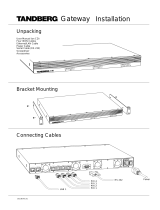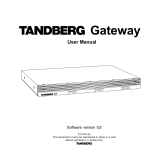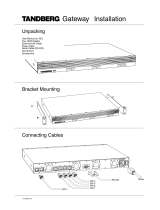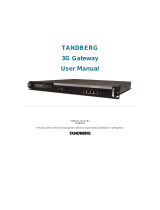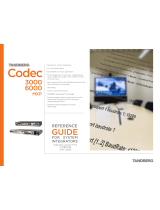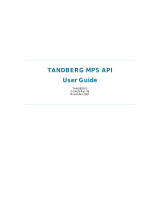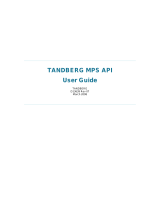Page is loading ...

This document is not to be reproduced in whole or in
part without the permission in writing from:
TANDBERG
TANDBERG GW
Dataport Command Interface User Guide
Software version G1.0
TANDBERG
D13202 Rev 01

TANDBERG GW Dataport Command Interface User Guide
D13202 Rev 01 2
Table of Contents
1.
INTRODUCTION..........................................................................................................................3
2.
CONNECTING TO THE DATAPORT COMMAND INTERFACE THROUGH THE RS-
232 PORT. ................................................................................................................................................4
2.1. H
ARDWARE
A
ND
C
ABLING
.......................................................................................................... 4
2.2. C
ONFIGURING
T
HE
D
ATAPORT
F
ROM
T
HE
W
EB
I
NTERFACE
........................................................ 5
2.3. T
ROUBLESHOOTING
......................................................................................................................5
3. CONNECTING TO THE DATPORT COMMAND INTERFACE USING TELNET............6
4.
THE TANDBERG GW COMMANDS......................................................................................... 7
4.1. I
NTRODUCTION
.............................................................................................................................7
4.1.1. Command format....................................................................................................................7
4.1.2.
Command types.......................................................................................................................7
4.2. T
HE COMMANDS
........................................................................................................................... 8
4.2.1. System Configuration Commands...........................................................................................9
4.2.2. General GW Commands....................................................................................................... 18
4.2.3.
System Status Commands...................................................................................................... 22
4.2.4. Debug Commands................................................................................................................. 28
4.2.5. Special Commands................................................................................................................30
4.3. P
ARAMETER
S
TORAGE
............................................................................................................... 31
4.4.
I
NDEX
C
OMMANDS
..................................................................................................................... 32

TANDBERG GW Dataport Command Interface User Guide
D13202 Rev 01 3
1. Introduction
The TANDBERG GW Dataport Command Interface User Guide contains guidelines on how
to use the textual command interface supported by the GW. The Dataport Command Interface
can be accessed through Telnet via the LAN interface or through RS-232 by connecting a
serial cable to the serial interface connector, referred to as the Dataport (ref. chapter 2). Three
Telnet sessions can be connected to the GW at the same time in addition to the RS-232
connection.
If, after reading this manual, you require additional information concerning the use of the
TANDBERG GW Dataport Command Interface, please contact your local TANDBERG
dealer who will be able to supply you with relevant information for special applications.

TANDBERG GW Dataport Command Interface User Guide
D13202 Rev 01 4
2. Connecting to the Dataport Command Interface through the
RS-232 port.
The RS-232 port is a 9-pin, female, D-sub connector located on the back of the GW. The port
is configured as a DCE (Data Communications Equipment). The RS-232 port is default set to
9600 baud, 8 databits, none parity and 1 stopbit from factory. The RS-232 port is also referred
to as the Dataport.
2.1. Hardware And Cabling
The pin outs for the RS-232 are defined in the following table (the DTE, Data Terminal
Equipment, could be a PC or other device capable of serial communication).
Pin no Signal Description Direction
1 CD Carrier detect To DTE
2 RD Receive data To DTE
3 TD Transmit data From DTE
4 DTR Data terminal ready From DTE
5 Ground
6 DSR Data set ready To DTE
7 RTS Ready to send From DTE
8 CTS Clear to send To DTE
9 RI Ring indicator To DTE
NOTE! A straight through cable should be used between the TANDBERG GW’s RS-232 port
and the DTE.
The figure below illustrates the recommended cable-wiring scheme for connecting the GW to
a PC through RS-232.
DTR and RTS are ignored. DSR, CD, and CTS are always asserted, while RI is not used.
TANDBERG GW PC
DCE, 9 pin DTE, 9 pin
1 CD 1 CD
2 RD 2 RD
3 TD 3 TD
4 DTR 4 DTR
5 GND 5 GND
6 DSR 6 DSR
7 RTS 7 RTS
8 CTS 8 CTS
9 RI 9 RI

TANDBERG GW Dataport Command Interface User Guide
D13202 Rev 01 5
2.2. Configuring The Dataport From The Web Interface
Click on System Configuration tab and then the Dataport button. The Dataport can be
configured by setting baudrate, parity, databits and stopbits.
2.3.
Troubleshooting
If communication cannot be established between the PC/terminal and the TANDBERG GW’s
Dataport the following should be checked:
• Verify that the serial cable is a straight through 9-pin to 9-pin cable
• Confirm that the configuration of the PC/terminal’s serial RS-232 port is identical to
the configuration of the TANDBERG GW RS-232 port.
• Verify that the PC/terminal’s serial RS-232 port is working properly by connecting it
back-to-back to another PC/terminal and send characters in both directions
1
.
1
It requires a null-modem cable to perform this test

TANDBERG GW Dataport Command Interface User Guide
D13202 Rev 01 6
3. Connecting to the Datport Command Interface using Telnet
The TANDBERG GW has two LAN ports. Connection to the Dataport Command Interface
via Telnet should be done through LAN port 1.
The GW’s Telnet server provides access to the Dataport Command Interface through a 10/100
base T network interface supporting the TCP/IP protocol.
When connected to the GW, the Telnet client will receive a welcome message similar to the
following:
Welcome to TANDBERG
TANDBERG GW Release G1.0
SW Release Date: 2003-07-01
NOTE! If the TANDBERG GW is protected by an IP password you will be prompted to enter
this password before you can access the Dataport Command Interface via Telnet.

TANDBERG GW Dataport Command Interface User Guide
D13202 Rev 01 7
4. The TANDBERG GW Commands
4.1. Introduction
Typing ‘?’ or ‘help’ when connected to the Dataport Command Interface will return a list of
valid commands. The commands are used to control the functions of the GW. A command
may be followed by a set of parameters and sub-commands. This chapter gives a description
of the valid commands for the GW.
4.1.1. Command format
Typing ‘?’ or ‘help’ after a command will result in a usage text being displayed. Usage text
gives information about the command format, i.e. valid parameters, sub-commands etc. An
example is shown below (the user input is shown in bold).
prichan ?
usage: prichan <PRI interface> max <number>
or: prichan <PRI interface> high <number>
or: prichan <PRI interface> low <number>
or: prichan <PRI interface> search <high/low>
-
PRI interface - a/b/c/d
number : 1..23
Parameters
are arguments upon which the command will operate. Required parameters are
denoted by: < >, while optional parameters are denoted by: [ ]. The possible values for a given
parameter are separated with slashes ( / ). For some parameters, only the parameter name is
supplied within the brackets. In these cases a specific parameter value is to be substituted for
the parameter name. The possible values to be substituted for a parameter name are often
supplied below if it is not obvious what the possible values are.
Sub-commands
are commands grouped together within a command. Different sub-commands
within a command may have different parameter sets. In the example above: max, high, low,
search are sub-commands to the command prichan.
NOTE! The Dataport Command Interface is not case sensitive.
4.1.2. Command types
The commands can be divided into three major classes:
• System Commands
• Parameter Setting Commands
•
Status Commands
System Commands
are commands that initiate processes in the GW. E.g.: The command
calltransfer initiates the process of transferring a call.
If the command is not syntactically correct, the GW returns ERROR. If the command is
syntactically correct, but the system is not accepting the command, *R response feedback is
issued followed by ERROR. If the command is syntactically correct and the command is
accepted, the GW returns OK. An example of *R response feedback is shown below in the

TANDBERG GW Dataport Command Interface User Guide
D13202 Rev 01 8
case where the user is trying to transfer a call from an inactive GW port (the user input is
shown in bold).
calltransfer 1 999999
*R Invalid gateway id
ERROR
Parameter Setting Commands
are commands that set a system parameter to a specific value.
E.g.: The command ippassword sets the valid password needed to establish an IP connection
with the GW to a specific value.
If the command is syntactically correct the GW returns OK, otherwise the GW returns
ERROR. If *P parameter feedback is activated (ref. command feedback), and the parameter
is successfully changed, the GW will return the command with the new value. An example of
*P parameter feedback is shown below (the user input is shown in bold).
pardial on
OK
*P pardial on
When issuing a Parameter Setting Command with no parameter, the GW will return the
command with the current setting. E.g.:
pardial
*P pardial on
OK
Status Commands
are commands that list different sets of system parameters. If *S status
feedback is activated (ref. command feedback), status commands are automatically called
when corresponding parameters are being changed.
4.2. The commands
The commands are divided into five groups: System Configuration Commands, General GW
Commands, System Status Commands, Debug Commands and Special Commands.

TANDBERG GW Dataport Command Interface User Guide
D13202 Rev 01 9
4.2.1. System Configuration Commands
Command: Description:
defvalues set
This command is used to restore factory default settings. Issuing this command with
no parameters will restore all settings except network settings and option key.
To reset all values to factory defaults the optional parameter
all
or *
factory
should
be added. Please download the parameter file, or write down the optionkey before
you execute this command (issue the command
optionkey
to view the current value
of the optionkey)
.
defvalues set [all/factory]
*
Adding the optional parameter factory, the eeprom will be erased and the flash
disk will be formated.
h323gatekeeper
Sets gatekeeper parameters.
NOTE! H.323 services must be set before the GW can be registered to a gatekeeper,
ref. command gwh323service.
h323gatekeeper <on/off>
or
h323gatekeeper address <ipaddress>
---
sub-commands:
• address:
Sets the IP address of the gatekeeper
Example of
h323gatekeeper
feedback:
*P h323gatekeeper on
*P h323gatekeeper address 10.0.0.30
ipaddress
Configures the LAN interfaces when static IP address allocation is used (the
command
ipassignment
is used to select between DHCP and static IP address
allocation).
NOTE! The GW needs to reboot before the changes will apply.
ipaddress [LAN interface] static <ipaddress>
or
ipaddress [LAN interface] subnetmask <ipaddress>
or
ipaddress [LAN interface] gateway <ipaddress>
---
parameters:
• LAN interface: 1.
Number identifying the LAN interface. If this
parameter is omitted the command applies to all interfaces (only interface
1
is in use).
sub-commands:
• static:
Sets the static IP address for the given LAN interface.
• subnetmask:
Sets the subnet mask variable for the given LAN interface.
Subnet mask defines the network class. If the setting is 255.255.255.0 the
local network will support up to 256 nodes, denoting a class C network. If
the setting is 255.255.0.0 the local network is a class B network with
65536 addressable nodes.
• gateway: Sets the gateway IP address for the given LAN interface. If a
gateway is located on the LAN and the GW needs to reach nodes through
this gateway, the gateway address can be set using the gateway variable
(the IP address of the gateway will be set automatically if the GW is in
DHCP mode)

TANDBERG GW Dataport Command Interface User Guide
D13202 Rev 01 10
Example of
ipaddress
feedback:
*P ipaddress 1 static 10.0.5.98
*P ipaddress 1 subnetmask 255.255.0.0
*P ipaddress 1 gateway 10.0.0.1
ipassignment
Selects between DHCP (Dynamic Host Configuration Protocol) or static IP address
allocation. When DHCP is selected the GW will automatically receive all the
necessary information from the DHCP server. This function should be used when
the GW is connected to a LAN using DHCP. When using this mode, IP-address and
IP-subnet mask are not used because the DHCP server supplies these parameters.
ipassignment [LAN interface] <dhcp/static>
---
parameters:
•
LAN interface: 1.
Number identifying the LAN interface. If this
parameter is omitted the command applies to all interfaces (only interface
1
is in use).
Example of
ipassignment
feedback:
*P ipassignment 1 static
ipmtu
Sets the maximum IP packet size to be used for H.323 calls. It can be useful to
reduce the packet size when packets are transmitted over links that add overlay
(f.ex. VPN). Reducing the packetsize will prevent the packets from being
fragmented.
ipmtu <1200-1400>
Example of ipmtu feedback:
*P ipmtu 1400
ippassword
Sets a password to restrict access to the GW’s webserver, telnet and ftp resources.
ippassword [LAN interface] <password>
---
parameters:
•
LAN interface: 1.
Number identifying the LAN interface. If this
parameter is omitted the given value is set for all interfaces (only interface
1
is in use).
• password: Textstring of maximum 16 characters. If the password is
forgotten it can be deleted using the command
ippassword “”
through the
RS-232 port.
NOTE! The default password is “TANDBERG”.
ipspeed
Sets LAN port speed.
NOTE! The GW needs to reboot before the changes will apply.
ipspeed [LAN interface] <speed>
---
parameters:
• LAN interface: 1.
Number identifying the LAN interface. If this
parameter is omitted the given value is set for all interfaces (only interface
1
is in use).
•
speed: auto/10half/10full/100half/100full.
The speed is either set to auto
or manually from 10mb half duplex to 100mb full duplex. When set to
auto the GW will automaticall
y
ne
g
otiate with the network and use the

TANDBERG GW Dataport Command Interface User Guide
D13202 Rev 01 11
best available setting.
Example of
ipspeed
feedback:
*P ipspeed 1 auto
ipqos
Configures the different Quality of Service (QoS) algorithms supported by the
TANDBERG GW. QoS are used to set priority on QoS enabled IP networks.
ipqos prectlph <chantype tlph> <precvalue>
or
ipqos diffstlph <chantype tlph> <diffsvalue>
or
ipqos precvtlph <chantype vtlph> <precvalue>
or
ipqos diffsvtlph <chantype vtlph> <diffsvalue>
or
ipqos mode <precedence/diffserv/off>
or
ipqos tos <delay/throughput/reliable/cost/off>
or
ipqos rsvp <auto/off>
---
parameters:
•
chantype tlph: audio/signalling.
Indicates which channel type the setting
applies to.
•
chantype vtlph: audio/video/data/signalling.
Indicates which channel
type the setting applies to.
• precvalue: 1-7/auto/off. The priority value to be used for IP Precedence.
When set to auto the system will use the Cisco recommended values. For
video telephony calls this value is 6 for signalling channels and 4 for audio
channels and video channels.
•
diffsvalue: 0-63.
The priority value to be used for Differentiated Services
(DiffServ).
•
modevalue: ipprecedence/diffserv/off.
Possible priority algorithms.
•
tosvalue: delay/throughput/reliable/cost/off.
Possible routing priority
values.
sub-commands:
• prectlp:
Sets IP Precedence value to be used for voice over IP calls.
• diffstlph:
Sets the Differentiated Services (DiffServ) value to be used for
voice over IP calls. DiffServ is an extension of IP Precedence and enables
division of IP traffic into 63 classes with different priority. Should be used
instead of IP Precedence if possible.
•
precvtlph:
Sets IP Precedence value to be used for video over IP calls.
•
diffsvtlph:
Sets the Differentiated Services (DiffServ) value to be used for
video over IP calls.
•
mode:
Sets which priority algorithm to be used.
•
tos:
Sets the routing policy the router should use when routing a call. If
supported by the router, the endpoint can signal to the router to select a
route that gives: “Minimum
delay
, maximum
throughput
, maximum
reliable
or minimum
cost
.
• rsvp:
Sets the Resource Reservation Protocol (RSVP) to on or off. When
RSVP is set to on, the TANDBERG GW will signal to the network the
minimum bandwidth and minimum delay required to make a call. RSVP
will try to reserve the resources required. If granted, Quality of Service
will be ensured during the whole call.
NOTE! The network has to be RSVP enabled to use this protocol

TANDBERG GW Dataport Command Interface User Guide
D13202 Rev 01 12
Example of
ipqos
feedback:
*P ipqos prectlph audio auto
*P ipqos diffstlph audio 0
*P ipqos precvtlph audio auto
*P ipqos precvtlph signalling auto
*P ipqos precvtlph video auto
*P ipqos precvtlph data auto
*P ipqos diffsvtlph audio 0
*P ipqos diffsvtlph signalling 0
*P ipqos diffsvtlph video 0
*P ipqos diffsvtlph data 0
*P ipqos mode precedence
*P ipqos tos off
*P ipqos rsvp off
isdnprot
Defines various ISDN protocol settings.
isdnprot nsftel <number>
or
isdnprot nsfvid <number>
or
isdnprot sendcomplete <on/off>
or
isdnprot restart <on/off>
or
isdnprot alert <on/off>
or
isdnprot hlc <on/off>
---
sub-commands:
•
nsftel / nsfvid:
Selects Network Service Facility for videophony or
telephony on PRI-T1.The NSF can be configured as “” (no value) or any
number
between
0-31
to describe the service facility on your PRI-T1 line.
To enter the NSF value you must know the profile used for your line.
• sendcomplete:
The Q.931 message "Sending complete" can be turned
off
.
This is only applicable for some Australian switches, which stop outgoing
calls when the message “send complete” is sent to the switch.
•
restart:
When restart is set to
on
the PRI interfaces will be reinitialized
after boot.
•
alert:
If set to
on,
the system will respond with an alert message to all
incoming setup messages. If set to
off,
the system will respond with an
alert message only to the incoming setup message related to the initial
channel.
•
hlc:
Turns sending of HLC information element in setup message
on
or
off
(video calls only)
.
Example of
isdnprot
feedback:
*P isdnprot nsftel ""
*P isdnprot nsfvid ""
*P isdnprot sendcomplete off
*P isdnprot restart on
*P isdnprot alert on
*P isdnprot hlct on
netprofile
Network profiles are used to predefine a set of call prefixes to be used by directory
entries.
netprofile <profile number> <call prefix> [profile name] [network]

TANDBERG GW Dataport Command Interface User Guide
D13202 Rev 01 13
---
parameters:
•
profile number: p1/p2/p3/p4/p5/p6
. The GW can hold as many as six
profiles (p1, p2 and p3 are predefined and can not be changed).
•
call prefix:
The prefix number for this profile.
•
profile name:
The profile’s name. Textstring of maximum 8 characters.
•
network: auto/h320/h323
NOTE! This parameter will be overridden by the GW, ref. command
calltransfer.
Example of
netprofile
feedback:
*P netprofile p1 "" Auto auto
*P netprofile p2 "" ISDN h320
*P netprofile p3 "" H323 h323
*P netprofile p4 0 Ext auto
*P netprofile p5 1 test auto
*P netprofile p6 2 test2 auto
pardial
Sets parallel dial mode for BONDING calls. If
pardial
is set to
off
the GW will set-
up BONDING calls by dialling all channels in a sequential manner, i.e. the system
will wait for a connection on the current channel before attempting to connect the
next.
pardial <on/off>
---
Example of
pardial
feedback:
*P pardial off
pricable
Sets PRI interface cable lengths.
pricable [PRI interface] <cablelength>
---
parameters:
• PRI interface: a/b/c/d.
Letters identifying the different PRI interfaces. If
this parameter is omitted the given value is set for all interfaces.
o
a
: PRI interface 1
o
b
: PRI interface 2
o c
: PRI interface 3
o d
: PRI interface 4
• cablelength: 1/2/3/4/5.
o 1
: 0-133 ft (0-40 m)
o
2
: 133-266 ft (40-81 m)
o 3: 266-399 ft (81-122 m)
o 4
: 399-533 ft (122-162 m)
o 5
: 533-655 ft (162-200 m)
Example of pricable feedback:
*P pricable a 1
*P pricable b 1
*P pricable c 1
*P pricable d 1
prichan
This command is used to configure the channel hunting strategy for the PRI
interfaces.
prichan <PRI interface> max <1..23/30>
or

TANDBERG GW Dataport Command Interface User Guide
D13202 Rev 01 14
prichan <PRI interface> low <1..23/31>
or
prichan <PRI interface> high <1..23/31>
or
prichan <PRI interface> search <high/low>
---
parameters:
• PRI interface: a/b/c/d. Letters identifying the different PRI interfaces.
o a
: PRI interface 1
o b
: PRI interface 2
o
c
: PRI interface 3
o d: PRI interface 4
sub-commands:
• max:
Sets a limit on the number of channels that will be available for
incoming and outgoing calls.
Values: 1-23 for T1 PRI, 1-30 for E1 PRI.
•
low:
Used together with
high
to define the line hunting strategy. The GW
will search for available channels between low and high. This allows other
devices to reserve channels outside this range
Values: 1-23 for T1 PRI, 1-31 for E1 PRI.
• high:
ref. low
• search:
Specifies if the search for available channels are to start from the
lower or higher limit.
Example of
prichan
feedback:
*P prichan a max 23
*P prichan a low 1
*P prichan a high 23
*P prichan a search high
pricrc4
Turns the the CRC check for PRI-E1
on/off
. CRC is default on and should stay on
in most cases.
pricrc4 [PRI interface] <on/off>
---
parameters:
•
PRI interface: a/b/c/d.
Letters identifying the different PRI interfaces. If
this parameter is omitted the given value is set for all interfaces.
o a
: PRI interface 1
o b
: PRI interface 2
o
c
: PRI interface 3
o d: PRI interface 4
Example of
pricrc4
feedback:
*P pricrc4 a on
*P pricrc4 b on
*P pricrc4 c on
*P pricrc4 d on
prinet
Selects ISDN PRI protocol.
prinet <protocol>
---
parameters
:
• protocol: ni/att/euro.
o
ni
- National ISDN (North America)
o att
– AT&T ISDN (North America)

TANDBERG GW Dataport Command Interface User Guide
D13202 Rev 01 15
o euro
-
Euro ISDN
Example of
prinet
feedback:
*P prinet att
prinumbrange
Defines the PRI number range for the various PRI interfaces.
prinumbrange <PRI interface> <lowest number> <highest number>
---
parameters:
•
PRI interface: a/b/c/d.
Letters identifying the different PRI interfaces.
o
a
: PRI interface 1
o b: PRI interface 2
o c
: PRI interface 3
o d
: PRI interface 4
prinumbtrunk
Enables or disables the use of PRI trunk groups. When trunk groups are enabled, the
PRI number range defined for PRI interface 1 applies to all PRI interfaces.
prinumbtrunk <on/off>
services
Enables or disables access to various system services.
NOTE! Changes become effective after reboot.
services ftp <on/off>
or
services telnet <on/off>
or
services telnetchallenge <on/off> [23/57]
or
services http <on/off>
or
services https <on/off>
or
services snmp <on/off/read-only/traps-only>
sub-commands
• ftp:
Sets access to the internal FTP server of the GW on or off
• telnet:
Sets access to the internal telnet server of the GW on or off.
NOTE! When set to off, telnet can only be re-enabled through RS-232
• telnetchallenge:
Telnet challenge can be enabled on either ip port 23 or ip
port 57. When connecting to an ip port that has telnetchallenge set to on,
an MD5 encryption challenge string are being issued instead of a password
prompt. An encrypted password based on the challenge string must then be
generated by an MD5 encryptor and sent back to the system as a response
in order to get access to the system.
NOTE! Regular Telnet are using ip port 23. When Telnetchallenge are set
to ip port 23, this will override regular Telnet.
• http:
Sets access to the internal web server, via HTTP, on or off.
• https: Sets access to the internal web server, via HTTPS, on or off.
•
snmp:
Sets access to the SNMP mib to on, off, read-only or traps-only.
NOTE! To obtain a high level of security the services FTP, telnet, HTTP and SNMP
should be set to off, while HTTPS is set to on. In addition an IP password should be
set, ref. command ippassword.
Example of
services
feedback:
*P services telnet on
*P services telnetchallenge on 57

TANDBERG GW Dataport Command Interface User Guide
D13202 Rev 01 16
*P services http on
*P services https on
*P services snmp on
*P services ftp on
sendnum
Enables/disables broadcast of the local unit’s number during H.320 call setup.
NOTE! The transfer of the local number to a remote system or the prevention
thereof is dependent on the feature set supported by the network or networks
between the GW and the endpoint.
sendnum <on/off>
---
Example of
sendnum
feedback:
*P sendnum on
snmp
Configures the snmp mib.
Note! For more information about SNMP please read the TANDBERG SNMP
application note.
snmp cn <community name>
or
snmp sc <system contact name>
or
snmp sl <system location name>
or
snmp hi <host ip address.> [host ip address] [host ip address]
---
parameters:
• community name: Textstring of maximum 16 characters.
•
system contact name:
Textstring of maximum 50 characters
•
system location name:
Textstring of maximum 50 characters
•
host ip address:
ip address
sub-commands:
• cn:
Used to set the
community name
parameter.
• sc: Used to set the system contact name parameter.
•
sl:
Used to set the
system location name
parameter.
•
hi:
Used to set the
host ip address
parameters.
Example of
snmp
feedback:
*P snmp hi 10.0.2.255 "" ""
*P snmp sl ""
*P snmp sc TANDBERG
*P snmp cn public
sport
This command is used to configure the serial port by setting baudrate, parity,
databits and stopbits.
sport [baudrate] [parity] [databits] [stopbits]
---
parameters:
•
baudrate: 1200/2400/4800/9600/19200/38400/57600/115200
•
parity: n/o/e
•
databits: 7/8
• stopbits: 1/2

TANDBERG GW Dataport Command Interface User Guide
D13202 Rev 01 17
Example of
sport
feedback:
*P sport 9600 n 8 1
systemname
Sets the GW name.
systemname <name>
---
Parameters:
• name: Textstring of maximum 16 characters.
Example of
systemname
feedback:
*P systemname TANDBERG

TANDBERG GW Dataport Command Interface User Guide
D13202 Rev 01 18
4.2.2. General GW Commands
Command: Description:
calltransfer
Disconnects the h323 terminal of a GW call and reconnects to another h323 terminal,
by either specifying a telephone number or by referring to a directory entry.
calltransfer <gwid> <number>
or
calltransfer <gwid> <11..l99> - (get number from directory)
---
parameters:
• gwid: 1..16.
Identifier referring to a GW call.
NOTE! When referring to a directory entry the GW will override the calltype
specified by the directory entry and the network type specified by the netprofile
command.
directory
Creates a directory entry in the directory list. The directory entry list can hold as
many as 99 directory entries. The directory are used together with the calltransfer
command.
directory <entry no> [number[**2ndNumber]] [calltype[r]] [profile] [name]
or
directory add [number[**2ndNumber]] [calltype[r]] [profile] [name]
or
directory all
or
directory delete <entry no>
---
parameters:
•
entry no: 1..99.
Specifies an entry number where to add or retrieve a
directory entry (only supplying the entry number will retrieve the given
entry).
NOTE! The user should be aware not to overwrite existing entries.
• number:
The phone number to be stored for this entry. If the destination is
a unit using H221, two numbers can be supplied separated by
**
.
• calltype:
tlph/2xh221/2b/3b/4b/5b/6b/8b/12b/18b/23b/30b/h0/auto
. An
optional
r
can be added after the calltype parameter to denote a restricted
call.
NOTE! This parameter will be overridden when using calltransfer.
• profile: p1/p2/p3/p4/p5/p6. Selects one of the predefined netprofiles, ref.
command
netprofile
.
• name:
The contacts name.
NOTE! If the name contains spaces the name has to be embraced by
quotes, e.g. “John Johnsen”
sub-commands:
• add: Adds the specified directory entry to the first vacant entry in the
directory list.
• all:
Lists all nonempty directory entries
• delete: Deletes a specified entry.
Example of
directory
feedback:
*P directory 99 123456789 auto p1 TANDBERG
disc
Disconnects a GW call.

TANDBERG GW Dataport Command Interface User Guide
D13202 Rev 01 19
disc <gwid>
---
parameters:
• gwid: 1..16. Identifier referring to a GW call.
gwdid
Sets ISDN DID (Direct Inwards Dialling) parameters. When DID is enabled the GW
will strip of the last digits in the ISDN incoming number and use this extracted
number to dial the h323 terminal. The number of digits to strip of the incoming
number and use as h323 number can be specified.
gwdid mode <on/off>
or
gwdid numbofdigits <numbofdigits>
or
gwdid maxbw <bw>
or
gwdid h323callprefix <callprefix>
---
parameters:
•
bw: 64/128/192/256/320/384/512/768/1152/1472/1920
sub-commands:
• mode: Enables or disables DID.
•
numbofdigits:
Sets the number of digits to extract from the ISDN
incoming number and use as h323 number.
• maxbw:
Sets the maximum bandwidth to be used when setting up a GW
call using DID.
• h323callprefix:
Defines an h323 dial prefix to add to the h323 number
extracted from the incoming ISDN number.
gwextdialin
Defines the ISDN extension dial in mode and corresponding ISDN number. When
the extension dial in number is being called the GW will request an extension
number to connect to the h323 terminal.
gwextdialin [id] mode <off/ivr/ivrtcs4>
or
gwextdialin [id] isdnnumber <isdnnumber>
or
gwextdialin [id] maxbw <bw>
or
gwextdialin [id] description <description>
parameters:
• id: 1
• bw: 64/128/192/256/320/384/512/768/1152/1472/1920
sub-commands:
•
mode:
Sets the extension dial in mode to off, ivr or ivr/tcs-4.
•
isdnnumber:
Defines the ISDN number the GW will use as ISDN
extension dial in number.
•
maxbw:
Sets the maximum bandwidth to be used when setting up a GW
call using extension dial in.
• description: To set an informative text.
gwh323service
Defines h323 services. H323 service prefixes are being registered at the gatekeeper.
When dialing from an h323 terminal, one of the GW’s service prefixes must be
dialed followed by the ISDN number to connect to.

TANDBERG GW Dataport Command Interface User Guide
D13202 Rev 01 20
gwh323service <id> servprefix <e164prefix>
or
gwh323service <id> maxbw <bw>
or
gwh323service <id> isdncallprefix <callprefix>
or
gwh323service <id> restrict <on/off>
or
gwh323service <id> description <description>
parameters:
• id: 1..20. Identificator referring to a specific h323service.
•
bw: 64/128/192/256/320/384/512/768/1152/1472/1920
sub-commands:
• servprefix:
Sets the service prefix for this h323 service.
• maxbw:
Sets the maximum bandwidth to be used when setting up a GW
call using this h323 service.
• isdncallprefix:
Defines
an isdn call prefix to be added to the ISDN number
to dial.
•
restrict:
Sets restrict to on or off.
• description:
To set an informative text for this h323 service.
gwhotline
Hotline numbers are used to map an incoming ISDN number to an h323 number.
gwhotline <id> isdnnumber <isdnnumber>
or
gwhotline <id> h323alias <E164alias>
or
gwhotline <id> maxbw <bw>
or
gwhotline <id> description <description>
parameters:
• id: 1. Identificator referring to a specific hotline entry.
•
bw: 64/128/192/256/320/384/512/768/1152/1472/1920
sub-commands:
• isdnnumber:
Defines the hotline ISDN number.
• h323alias
: Defines the corresponding h323 number for this hotline entry.
• maxbw: Sets the maximum bandwidth to be used when setting up a GW
call using this hotline.
• description:
To set an informative text for this hotline entry.
NOTE! Only one hotline entry is supported in this version of the TANDBERG GW.
gwloadlimit
The GW will signal busy to the gatekeeper when the current load on the GW reaches
this limit.
The current system load can be monitored by the status command systemload.
gwloadlimit <0..100>
gwsettings
To avoid interoperability problems, the GW can be configured to not support some
features.
gwsettings natvid <on/off>
or
gwsettings customformats <on/off>
/
